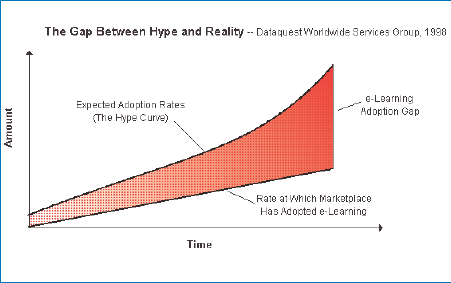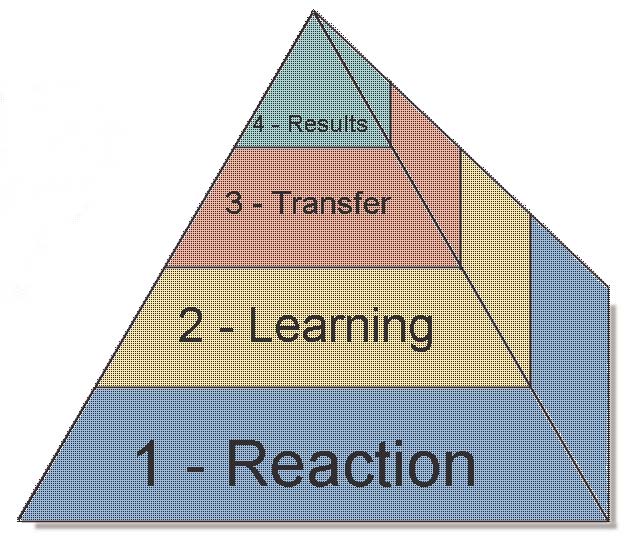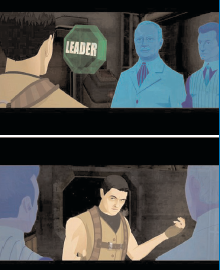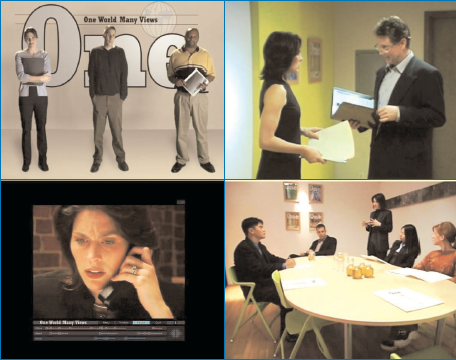What if taking a training course were as interesting and engaging as watching a good movie? What if people in your organization were not only eager to take your e-Learning course but were disappointed when it was over? Sound too good to be true? Well, maybe it’s not. Maybe the challenge is not a technical one but a creative one.
Some companies are successfully using the techniques and approaches that the film and TV industries use to capture and cultivate our attention, and are applying them to organizational learning.
Before citing some specific examples lets look at what’s been going on in e-Learning in recent years. Let’s look at how we hoped e-Learning would be embraced versus how it actually has been embraced. The expected rate of adoption of e-Learning in the marketplace differs significantly from the actual adoption rate. (See Figure 1.) There are a myriad reasons for this but it seems that learner resistance and finding the time are very near the top of the list.

FIGURE 1 The expected rate of adoption of e-Learning differs significantly from the actual adoption rate.
Finding the time is a corporate culture and management issue but I believe learner resistance is something very different. Could it be that people resist e-Learning in their companies because, well...it’s boring? Could it be due to the fact that most e-Learning is still text-based with the odd JPEG or MPEG thrown in for good measure?
“We provide e-Learning” tells you as much about how a company delivers learning as “I’m a consultant” tells you what someone does for a living. At one end of the e-Learning spectrum is the static page full of text with a “Next” link at the bottom. At the other end is rich, compelling, well designed, interactive multimedia that engages intrigues, excites, and more importantly... seems to work. It’s the latter that I will address here — the fun stuff that learners love to engage with and want more of. Most e-Learning we see lives somewhere on the scale between these extremes and too often it’s towards the lower end of the scale. Too many companies invested in the idea of e-Learning rather than investing in the design of effective e-Learning. Some organizations are more concerned with broadcasting the fact that they now have “e-Learning solutions” than in shaping and determining its value.
The cost effectiveness paradox
Organizations speak a lot about the cost effectiveness of e-Learning solutions. Every e-Learning website you see shows the graph of e-Learning costs vs. traditional instructor-led-training (ILT) costs and how hundreds of thousands of dollars can be saved. However, the research shows that most evidence for effectiveness is purely qualitative. The Kirkpatrick evaluation levels 2 through 4 are rarely applied to e-Learning (See Sidebar 1 “Kirkpatrick Evaluation Levels”).
|
Kirkpatrick’s four progressive levels of evaluation: Level 4: Results is a measure of the business outcomes that occur because they are doing their jobs differently. Level 3: Transfer is a measure of changes in their behavior when they return to the job after the training program. Level 2: Learning is a measure of what they learned. Level 1: Reaction is a measure of learners’ reactions to the course. |

|
Judith B. Strother of the Florida Institute of Technology reviewed e-Learning research in April 2002 with a paper entitled, “An Assessment of the Effectiveness of e-Learning in Corporate Training Programs.” She writes:
“Wise training managers realize ‘the bitterness of poor quality remains long after the sweetness of low price has been forgotten.’ To justify making decisions about training programs independently of training cost considerations, managers need concrete measures of program effectiveness. While there is no doubt that we see an increasing number of case studies showing success with e-Learning, it is still difficult to find solid research measures of learner achievement in the specialized setting of a corporate training program.”
“An American Society of Training and Development (ASTD) study found that 67 percent of the training directors interviewed do not measure the effectiveness of their web-based programs at all.” And in her conclusion:
“While few people debate the obvious advantages of e-Learning, systematic research is needed to confirm that learners are actually acquiring and using the skills that are being taught online, and that e-Learning is the best way to achieve the outcomes in a corporate environment.”
Most of us believe that e-Learning definitely has value and can be effective but as the research shows — most companies are not measuring the learning, transfer and results in any quantitative fashion.
So we don’t really know how effective traditional e-Learning is — we can only go by smile sheets and a warm feeling in our stomach. Could it be that e-Learning is much less effective than it could be? Could it be we are just now scratching the surface of its possibilities? Yes — I believe this to be the case. And it’s not the medium and the technology that’s holding us back, it’s the way we are utilizing them. It’s a lack of instructional design sophistication and creativity. If we want to see the true power of what new media technologies can do for learning then we need to take our focus off of e-Learning management for a moment and put it on instructional design using the breadth of media that’s available to us.
I’ve highlighted several companies that are doing just this and making an effort to use the richness of new media to bring something more powerful and engaging to the e-Learning experience. As well as looking at e-Learning in the cognitive domain (the predominant use of e-Learning today) we’ll take a look at e-Learning in the affective domain; such things as communication, management, leadership skills, and other professional development skills. (See sidebar 2, “Bloom’s Domains”)
The results of Benjamin Bloom’s research in the 1950’s on the analysis of academic learning behaviors produced what is known today in the field of education, as Bloom’s Taxonomy. This hierarchy of learning behaviors was categorized into three interrelated and overlapping learning domains: the cognitive (knowledge), affective (attitude), and psychomotor (skills).
The Cognitive Domain
The Cognitive Learning Domain is exhibited by a person’s intellectual abilities. Cognitive learning behaviors are characterized by observable and unobservable skills such as comprehending information, organizing ideas, and evaluating information and actions.
The Affective Domain
The Affective Learning Domain addresses a learner’s emotions towards learning experiences. A learner’s attitudes, interest, attention, awareness, and values are demonstrated by affective behaviors. Most soft-skills training is primarily concerned with this domain.
The Psychomotor Domain
The psychomotor domain refers to the use of basic motor skills, coordination, and physical movement. These physical behaviors are learned through repetitive practice. A learner’s ability to perform these skills is based on precision, speed, distance, and technique.
“Soft skills” and e-Learning
The management, leadership and professional development area of training has so far proved difficult for many e-Learning companies to implement effectively. It is a challenge for e-Learning because we are attempting not to simply inform, teach cognitive skills, and build literacy but to change someone’s attitude, behavior and the way they relate in the world.
Teaching these skills effectively using technology solutions has always been a challenge but some companies are putting a stake in the ground with some compelling solutions. Some of these companies are thinking “outside the box” and using new media in ways we don’t often see in e-Learning.
So what is it that is needed to teach soft skills effectively? How can we affect someone’s behavior? How do we affect a learner’s relationships with others, develop awareness, influence value judgments, and change attitudes and behavior?
In each of these areas we want to create a lasting change. In order to effect lasting changes in behavior we need to affect a person’s emotions. In a recent eLearning Guild online poll, people were asked, “What is your biggest challenge in implementing e-Learning?” Respondents said “learner resistance” was by far the biggest challenge. Why is this? Do people not enjoy learning? I doubt it. Is the subject matter not relevant to their job? Perhaps. Are they are too busy to attend training? Maybe. Could it be that the training isn’t interesting, engaging, compelling and fun? A resounding Yes! Current e-Learning solutions are not engaging their audience sufficiently. It’s the same problem we have in schools — children play interactive video games, watch TV and movies, and then are bored to death watching Mr. Smith scribble words on a whiteboard.
In order to engage, interest and motivate, our emotions need to be put in gear. When this happens the reticular activating system in your brain gets activated. (See sidebar 3, “Reticular Activating System” .)
The Reticular Activating System is the attention center in the brain. It is the key to learning and is thought to be the center of motivation. The Reticular Activating System is a complex bunch of neurons which serves as a focal point for signals from the external world and from your inside world. It is the part of your brain where the world outside and your thoughts and feelings meet. It plays a significant role in determining whether a person can learn and remember things well or not, and whether a person is highly motivated or bored easily.
Moving images, sounds, music, light, interaction, drama and narrative all get the reticular activating system working overtime. Bullet points in a browser don’t!
What typically provides most of these in our life? Television and movies? Is watching TV relaxing? Yes. Is it engaging? Yes. Is it enjoyable? Yes. Do we learn anything? Yes. Does it affect the way we behave and think about the world? Yes.
TV and movies are, by far, two of the most powerful motivators and influencers in our life. And we love to watch them. They engage our interest and stimulate our emotions. We get engaged whenever and wherever we see a screen flickering. We even learn about things we’re not interested in.
What if e-Learning had this power to draw people in and have them glued? Could soft skills be taught more effectively? You betcha! Would learner resistance still be a problem? Probably not!
Companies using media effectively
Only a few companies
seem to be innovating in this genre of training product. Notables are Ninth
House, Trainingscape and substanz: — all based (coincidentally) in
Ninth House
Ninth House is known for providing business skills training, which leverages content from thinkers such as Tom Peters, Ken Blanchard, and Peter Senge. They have a catalog of business and management courses that utilize rich media and interactive simulations.
CEO Jeff Snipes says his strategy is, “...to create content so compelling that job training becomes a healthful habit, the corporate equivalent of daily exercise,”
Snipes works with a
mix of
1. Intellectual property of business thinkers (the content of the training)
2. Engaging use of media (the form of the delivery)
3. Implementation (transferring what is learned to the workplace) They have paid particular attention to the second one — the use of media. In their “eSeries,” Ninth House uses full motion video and interactive simulations to provide what they say is, “...high learner absorption and retention via engaging, entertaining and interactive ways that enables learning by experience.”
The interactive simulations allow employees to practice skills learned in the courses before applying them in the real world. By making decisions for characters in a series of TV-style episodes, learners test their knowledge in stories surrounding a fictional business and some of the challenges it faces.
One of these interactive simulations is “High Impact Hiring” based on a book by Joseph Rosse and Robert Levin called High-Impact Hiring: A Comprehensive Guide to Performance-Based Hiring. The course teaches hiring managers to use performance-based strategies to quickly and successfully identify the right talent for their organization in a highly competitive labor market.
This video drama takes place at WileyToys.com where Ty Meldy, the Division Director is searching for a new division controller. “Helpful” co-workers who want to assist him with the search and help him make the right hiring decisions surround him. The story combines professionally produced, TV-style drama and each video segment addresses a specific learning point. (See Figure 2.)

FIGURE 2 The “High Impact Hiring” video drama teaches managers to use performance based strategies.
The drama is light-hearted and humorous and at the end of each segment the learner is asked to make a choice of the best strategy or course of action. Then a video segment is played out showing you the consequences of your choice — a type of multi-path story that guides you in the right direction. You can observe first hand the outcome and possible impact of a poor decision. In the case of Ty you can often see comical consequences of poor choices you have him make. You get to experience failure gently.
The interactive simulations are part of a larger training process that includes developing awareness, visual modeling of performance, role-playing, workplace application and rewards programs. Ninth House has also used rich media in its “Instant Advice” product to create some “just-in-time” online learning modules their customers can access anytime they have a question. With a keyword search you can bring up a window with streaming video that addresses such topics as “Asking for Help,” “Providing Praise,” etc. — small video nuggets that convey information in a memorable form.
“Our goal is to bring together knowledge, technology, and entertainment to create broadband learning experiences that stick,” says Snipes.
Trainingscape
Trainingscape, with the tagline “Emotionally Charged Learning,” is utilizing similar entertainment industry approaches to deliver its animation and video movies. They have a staff of professional producers, cameramen, and actors, and create titles for professional development, leadership and compliance.
Eric Schiffer, the CEO at Trainingscape says, “Our goal has been to use sophisticated movie industry techniques to be able to engage people at an emotional level and therefore reinforce and cement their learning.” Schiffer and his team are proud of their latest offering on Situational Leadership” — it’s what you might call a SciFi training movie. It’s set in the year 2176 and designed to teach the leadership process that Dr. Paul Hersey has pioneered and evolved during the past 30 years.
Schiffer compares his product to watching a feature film and getting pulled in emotionally. “We take you on a journey — we pull you from your current reality into this new world.” The new leadership “journey” as they call it, streams animation segments across the net and is presented through Flash via a browser. (See Figure 3.)

FIGURE 3 “Situational Leadership”
applies sophisticated animation.
The journey starts
with a screen image as if you are sitting in a movie theater. The movie plays
out in the center of the screen and we see text fade in slowly and dramatically
to set the scene. “An environmental catastrophe forced a mass exodus of Earth.
Oxygen is the sole currency for the new interstellar communities. Only four
nations have survived,
Schiffer does not see his products as occupying the same space as other e- Learning products in the industry. He considers what Trainingscape is doing is worlds away from what’s currently available in the marketplace. “Our competition is not other e-Learning companies, it’s Time Warner, Disney and Electronic Arts.”
substanz:
substanz: is another company that utilizes the emotional impact of film and has taken management and leadership training one step further. substanz: also uses stories and the medium of movies to engage learners but with a twist — you can interact with the characters and experience multiple perspectives. They call their product a “hyperstory.”
A hyperstory is similar in concept to a hyper-link except that instead of linking to another page you link to another perspective. Substanz: describes it as “an interactive, multi-perspective ‘story’ that uses the engaging quality of a movie to create an evolving learning experience.”
Hyperstories are short movies with live actors, dialog and a storyline that highlights a specific scenario. The story is told in classic movie-style drama and substanz:, like Trainingscape, has gone to great lengths to create high-end productions. The sets, scripting and acting are impressive.
At certain times within the hyperstory, you can choose to change perspective and see exactly the same events but from another character’s point of view. When you do this, things appear a little different. What seemed an appropriate comment or behavior through one set of eyes, now takes on new meaning from this other viewpoint. The concrete events that happen remain exactly the same but the interpretation and nuance are different.
Craig Ashby, one of the founders of substanz: says the multiple perspectives within the interactive movies are key to their approach to teaching management and leadership skills. “Multiple perspectives are important because in any management or professional development training one of the biggest hurdles to overcome are those of understanding and appreciating another’s point of view. Understanding and valuing another opinion, attitude, or behavior is the first major step in being able to change our own response and behavior.”
One of the first hyperstory products that substanz: developed was a “Transition to Management” training program for the Boeing Leadership Center.
Boeing was facing the challenge of assisting up to a thousand new, first-level managers, from diverse business units, in making the transition from individual contributors to manager-leaders. They wanted something other than a point-and-click leadership- training program, something that could really engage and involve their audience. They needed a program that could be delivered remotely and yet still feel human and enriching to the participants.
One of the specific goals that they needed to achieve was to use an exciting, experiential, story-based learning tool that incorporated new types of interfaces and restored learner control. They also wanted to create a program that wasn’t based on “right” and “wrong” but that instead stimulated open dialog.
“Transition to Management” is based around a fictitious magazine called “One”. (See Figure 4.) As trainees experience the hyperstory on their PC or laptop, a drama unfolds based on the three main characters: a newly promoted manager, a team member and a manager of another department. We see Chloe, the new manager, hold her first staff meeting as team leader and deliver a speech to the co-workers she used to work alongside. Everything appears to go well, Chloe is energized, communicates well and feels she has inspired the team.

FIGURE 4 Four scenes from the “Transition to Management” hyperstory illustrate production values that add emotional impact.
Back in her office, a little later, things start to heat up when her old team mate and friend Stuart strides into her office and asks for a raise — he feels his contributions to the business are not recognized. He is upset and a little aggressive. Chloe is a little shocked by this and as the story develops we see the relationship between Chloe and Stuart start to deteriorate. Her relationship and rapport with other staff also starts to become a little uneven.
We can sympathize with Chloe, she seems to be managing things, listening to concerns and communicating well... or is she? After watching the story all the way through the management trainees have a teleconference and a facilitated discussion about their impressions, judgments and reactions.
Shortly afterwards the participants discover that they have been seeing everything from Chloe’s perspective. Trainees are now told that at certain key points in the story it’s possible to click on other characters in the story and see things from their perspective. When they do this, things begin to look a little different.
When they click on Stuart in the staff meeting they see Chloe delivering the same speech as before but in a more dis-jointed and nervous fashion. It is evident she is not involving the team in her conversation but appears to be talking at them. Stuart raises a hand several times, perhaps to ask a question or clarify something, but his request goes unnoticed by Chloe. The other staff exchange glances and raise eyebrows. There are a few uncomfortable pauses in Chloe’s speech that add to the sense that she is unsure of herself and her new role.
Later when Stuart strides into Chloe’s office he no longer seems the aggressive, demanding person that we saw earlier but a much calmer individual making what seems like reasonable, measured requests of his manager. We are reminded, as we see Stuart’s view of the situation, that it is our perceptions and biases that define our reality, not simply the words that are spoken. At the next teleconference for the trainees the discussions take on a new dimension as they consider each character’s interpretation of events and their resulting behavior. No black and white answers but rather a whole array of subtleties, complexities and grays.
“The hyperstory is not intended as a complete stand-alone training solution, it’s a catalyst in the learning process,” says Ashby, “it’s designed to engage, stimulate interest and be the reference point for discussion.”
So far, it seems, the trainees have embraced this interactive movie approach to learning. The results include very high completion rates, a much higher level of engagement in training, and a greater enthusiasm for participating in the training.
Engaging the learner
Too many organizations look to fast delivery, learning management or online testing and evaluation for solving some of their learning challenges. However, the real issue is engaging the learner such that he or she wants to learn, wants to know more and discover more. Getting and maintaining the learner’s attention is the key.
Because animations, movies and hyperstories are created in a medium that we are all intimate with, our attention is captured immediately. It’s not easy to just watch a part of it — we have to see it all, get the whole story, and see how things play out. Compare this to reading text in a browser or listening to an instructor teach from bullet-points on an overhead.
Stories are powerful! We remember stories because they are a narrative of events. Events can have meaning on their own, but a much greater meaning and impact when strung together. Think of the meaning of words individually or inside a sentence. Pixels of a graphic image seen close up are simply squares of color, but from a distance they become a recognizable pattern. Our brain is a powerful pattern recognition device. Stories are patterns of events. Think of all the great speakers who relate a story to make a point.
Well-produced and well-scripted film can relate a dramatic story that affects us on an emotional level. The colors, camera movements, and incidental music all combine to affect and move the viewer at a deeper emotional level. If emotion is attached to an image or event it is cemented forever in our brain’s vast web of neurons.
And in the case of the substanz: hyperstories, we have the tool of multiple perspectives. The idea of being able to access a different “reality” — to see a situation from multiple points of view hits on one of the crucial keys to management, leadership and professional development. The idea of being able to understand and live in another’s shoes... empathy. Think of the amount of communication problems in organizations that stem from either not understanding or not appreciating another’s point of view.
An enormous number of companies have attempted to move e-Learning forward by means of technology alone. They hang on to the linear, stream-of-information theory of learning, and use technology only to deliver it faster and further. They focus on moving it, delivering it and managing it. They rarely focus on “it” — that is, the form and substance of the learning. It’s using new media to bring the form and content of learning to life that’s going to solve the “learner resistance” problem we are seeing. Concentrating on bringing the content to life — literally — can enable e-Learning to become what effective learning has always been — interesting, engaging and fun.
(Editor’s note: There are many skill sets, budget issues, and development cycle changes involved in creating compelling content. We will be addressing these in future articles.)



